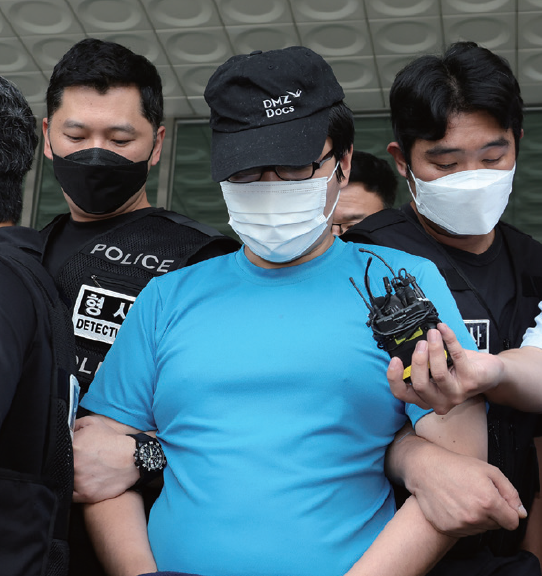On August 20th, JTBC Newsroom disclosed the name of the offender in the Sillim-dong murder case, Choi Yoon-jong, ahead of the police. Whether or not revealing a felony suspect’s personal details is appropriate requires a value judgment concerning the public’s right to know and the offender’s right to be protected. While positive public opinions about disclosing the personal details of suspects exist, problems remain unsolved. Therefore, the Sungkyun Times (SKT) aims to examine current controversies and potential solutions regarding the issue.
Current Status of Suspect Identity Disclosure
-The Concept of Suspect Identity Disclosure System
The suspect identity disclosure system is a mechanism where the information of violent criminal suspects, particularly those who have committed serious crimes such as assault, murder, and arson, becomes open to the public. This system’s background traces back to the 2004 Yoo Young-chul case and the 2006 Jeong Nam-gyu case, in which the undisclosed offenders’ identity information led to public controversy. Influenced by such public sentiment, in the 2009 Kang Hosun case, broadcasting organizations even went so far as to fully disclose the suspect’s photograph taken by the police. This incident further increased public demand to announce criminal identities for social security. Consequentially, the Act on Special Cases Concerning the Punishment of Specific Violent Crimes was enacted in 1991, and currently, identity disclosures are based on Article 8 of the legislation. According to the act, prosecutors can release identity details such as the name and age of a suspect charged with a specific violent crime. The criteria required for disclosure include using brutal means, sufficient evidence, and its benefit to the public interest. Lastly, the suspect who is a legal minor cannot be subject to the disclosure.

-Expected Benefits of Identity Disclosure
The initial purpose of the disclosure system was to protect the public’s right to know and prevent further crimes, and such a goal has been validated through several cases. As a policy providing information on felonies such as murder and assault, the disclosure system primarily serves to raise awareness of citizens by sharing the disclosed details, thereby improving communities. On August 7th, the Gyeonggi Southern Provincial Police Agency revealed the identity of, Choi Won-jong, the suspect in the Seohyeon Station Knife Incident, in which 14 victims were involved. The Police Agency evaluated the results positively, stating, “Especially in terms of the immense concerns about national insecurity due to the crime outbreak and the preventive effect in cases of copycat crimes, the disclosure greatly serves the public interest.” Additionally, after a threat to commit a knife attack at Hanti Station was posted online, the head of a private academic institution nearby asserted, “Disclosing not only the suspect’s name and face but also their residence and significant areas of activity could alleviate students’ fear.” Furthermore, the disclosure system can prevent recidivism. Disclosure makes suspects aware that their information might be publicized, leading to a deterrent effect on recidivism. This effect is especially beneficial in restricting felons, as Seung Jae-hyun, a researcher at the Institute of Criminal Policy, mentioned the high recidivism rate as a prominent characteristic of serious crimes. However, despite the initial purpose and the expected benefits, debates regarding the system’s justification and effectiveness are ongoing.
Drawbacks of Criminal Suspect Identity Disclosure
-Deprivation of Legitimacy

One problem is that the system of disclosing suspect details conflicts with the principle of presumption of innocence. As Article 27 of the Constitution states, this principle denotes that a suspect is innocent until proven guilty. Criminal Procedure Law Articles 307 and 325 state that any law contradicting this principle may have judicial issues. First, violating the presumption immediately labels suspects as guilty and infringes on personal rights. Secondly, the system can hinder a fair investigation. Public sentiment may intensify due to media exposure, potentially influencing judicial authorities and obstructing an impartial investigation. Furthermore, even if one values the citizens’ right to know over the presumption of innocence, it is not fully proven that disclosing personal details contributes directly to the public interest. The Supreme Court’s 1998 verdict stated, “There is no necessity to specify the identity of a suspect just to report on the crime. It cannot be assumed that reports on a suspect inherently have the same public interest as reports on the crime itself.” Therefore, disclosing suspect details does not necessarily guarantee public good when the presumption of innocence clashes with the citizens’ right to know.
-Lack of Systematic Effectiveness
Moreover, there exists a concern that disclosing suspect details is not an effective punishment for even those who are proven guilty. The criteria for disclosure, which requires the case to have sufficient evidence and be a threat to the public interest, is criticized for its ambiguity. The personal details of Jeong Yu-jeong, who murdered her peer in Busan on May 6th, were revealed, while those of Kim, who killed his ex-lover in Geumcheon District, Seoul, on May 26th, were not. This double standard has led citizens to question the fairness of the system. In addition, releasing identities results in stigmatization, hindering criminal rehabilitation due to societal labels. Convicts, labeled as murderers or rapists experience a “social death” in addition to their formal punishment, which in turn can increase the likelihood of reoffending. A professor from the Department of Psychology at Sungkyunkwan University spoke to the SKT, “Contrary to the original intention of the personal disclosure system, which hopes to prevent reoffending, the stigmatization effect can rather increase the potential for recidivism.” Hence, applying the system of disclosing personal details in practice can cause various unintended consequences.
For Ideal Punishment and Prevention
-Observing the Presumption of Innocence

To ensure suspect rights within the presumption of innocence principle, implementing a legitimate procedure that prevents unreasonable cases of disclosure is necessary. Attorney Lee Seung-hye commented, “To prevent further crimes, revealing photos during an investigation is less effective than after a sentence.” Until conviction, details should remain confidential, following the presumption of innocence. When a crime is proven to be a threat to the public interest, it would be necessary to disclose the personal details of the defendant, instead of the suspects. Although not every defendant is guilty, designating defendants rather than suspects as the subject of disclosure can be an alternative to balancing both the protection of personal rights and the public’s right to know. In the United Kingdom, suspect information is not released unless related to threats of public interest, and the names become open to the public after the indictment. This case is a precedent that compromises the presumption of innocence and public security. Thus, distinguishing between suspects and defendants can not only help avoid the violation of a suspect’s rights but also lower the possibility of unjust investigations.
-Maintaining Efficacy
For an effective system, a legal improvement for concrete interpretation must complement the ambiguous language of the current legislation. This change would help establish a system for convicting the actual “guilty suspects,” clearing false accusations, and providing accuracy in punishing crimes. When reforming the system, it is also crucial to consider that violent crimes are diverse and intensify over time. To minimize the ambiguity in the current criteria for disclosure, involving judicial bodies and experts to reflect the various aspects of felonies is necessary. Furthermore, procedural improvements can compromise between stigmatization and deterrent effects. Whether convicts re-offend due to social stigma or restrain due to public disclosure is vital in sentencing; therefore, a systematic plan to balance these differing effects is imperative. The current policy, which is ineffective in rehabilitating suspects should be replaced with a system that strengthens the actual punishment for severe crimes and reduces the stigma effect while maintaining the deterrent effect. The double punishment, in which citizens stigmatize the suspect based on disclosing their information, must be terminated, only leaving a strict single punishment by the state to deter recidivism.
With the media heatedly covering various felonies such as juvenile crimes, sexual assaults, and indiscriminate violence lately, the judiciary’s response to these issues is attracting significant attention. The policy of disclosing the personal information of suspects related to heinous crimes is a complicated matter intertwined with jurisprudential and substantial issues. Therefore, active discussion for solutions to these concerns is required. Through this exploration, the SKT hopes for a more secure society for future generations.
